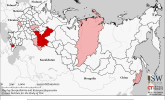Russian Volunteer Units and Battalions
July 16, 2022 - ISW Press
The Russian Federation has launched a large-scale drive to form volunteer battalions in the 85 “federal subjects” (or regions) that comprise the federation. Recruiting for some volunteer battalions began in June but has intensified in July, with new volunteer units being reported daily. The battalions apparently will consist of roughly 400 men each aged between 18 and 60. They will belong to various branches of service including motorized rifle, tank, and naval infantry, but also signals and logistics. Recruits are not required to have prior military service and will undergo only 30 days of training before deployment to Ukraine.










